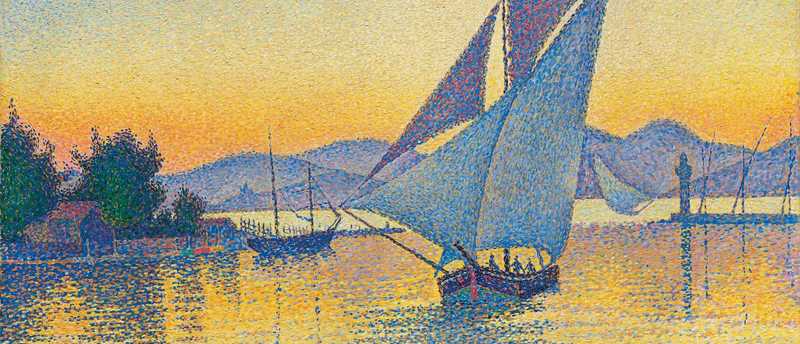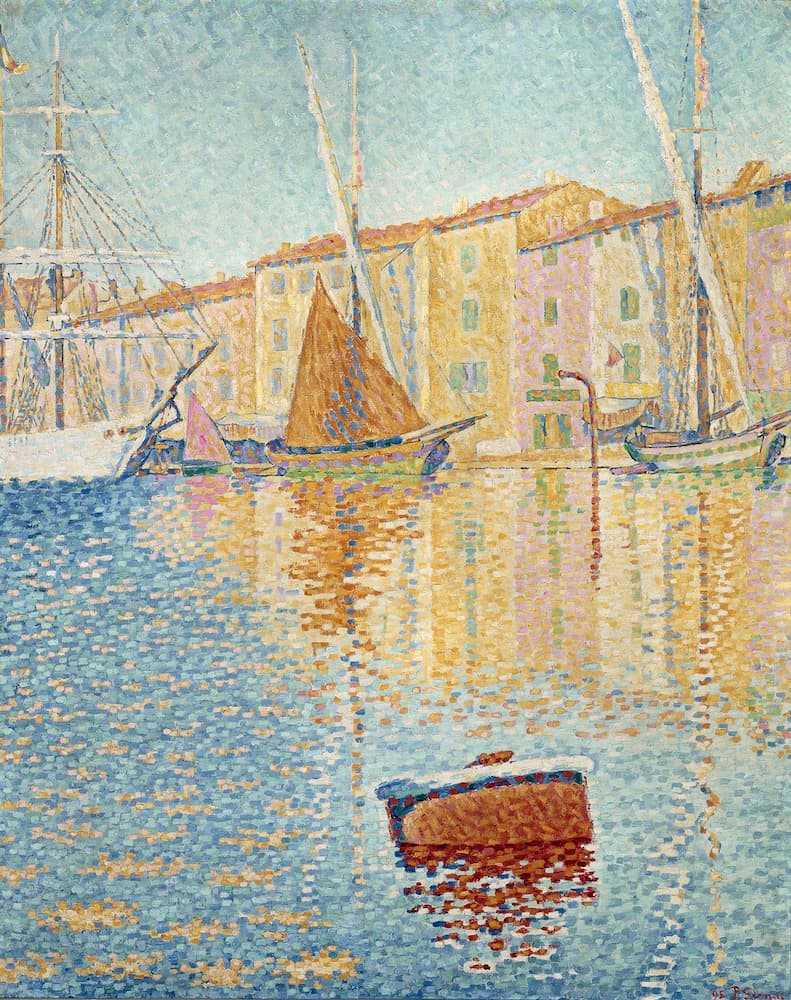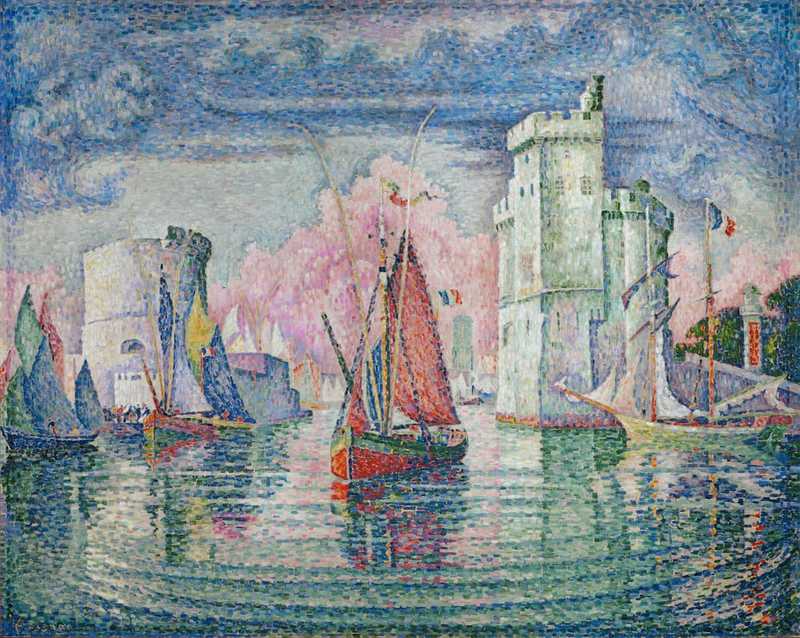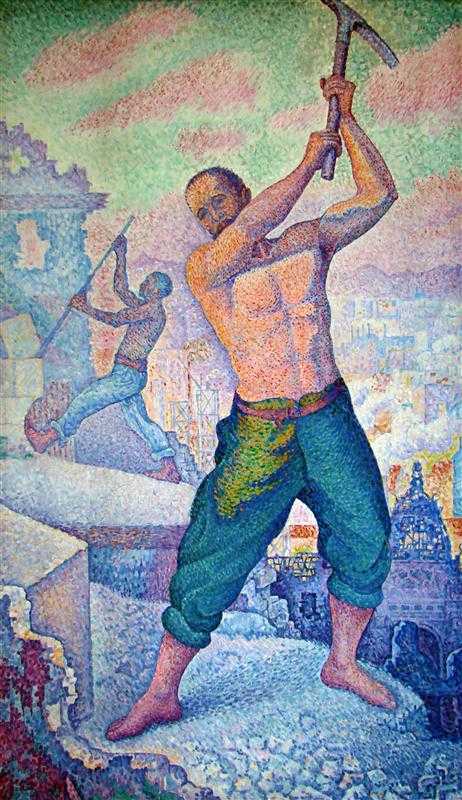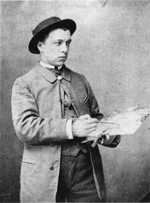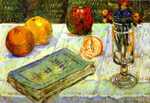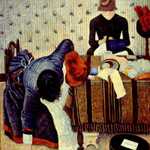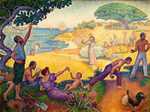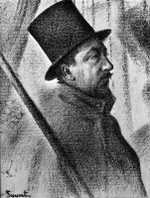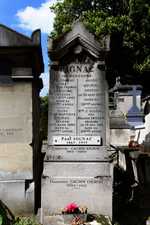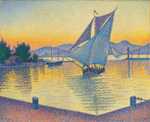1. Early Life
1863: Paul Signac is born on 11 November 1863, to Jules Jean-Baptiste Signac and Héloïse Anaïs-Eugénie Deudon. His father owns a shop on the Rue Frochot selling luxury horse saddles and harnesses. During his early childhood, Signac’s family moves to the Montmartre area of Paris, the avant-garde art center of an evolving city. Being raised in such an environment has its impact on Signac and he is encouraged by his parents to soak in the artistic culture and attend art exhibitions.
1877: Signac studies architecture at the Collège Rollin in Montmartre until 1880 (renamed the Lycée Jacques Decour).
2. Signac and Impressionism
Signac first started painting when was 18 years old, in the winter of 1881.
He was mostly self-taught but had received some basic instruction in art through Emile Bin, a history and portrait painter. Living in Montmartre among other artists influenced his art and he busied himself with observing the works of the revolutionary impressionists including Edouard Manet, Claude Monet, and Edgar Degas.
1880: Signac frequently attends galleries and exhibitions. In June, he visits Monet’s Paris exhibition at the offices of the cultural journal La Vie Moderne. Signac attends the fifth Impressionist exhibition. He is busy making quick sketches of an artwork by Edgar Degas when Paul Gauguin notices him. He rudely interrupts Signac and tells him “One does not copy here sir!” and has him removed from the exhibition.
The same year Signac loses his father to tuberculosis. The family is hit hard by his death and his mother Heloise decides to sell the house and the shop. The whole family moves to a Parisian suburb called Asnières. Signac isn’t happy in his new neighborhood and rents a room in Montmartre, alternating his time between the two places. Even though initially disappointed with Asnières, Signac finds plenty of painting opportunities, which result in beautiful outdoor sceneries. He has a passion for sailing and he has a canoe that he has named“Manet Zola Wagner" after his idols - the surnames of an artist, a writer, and a composer that he admires.
1881: Signac quickly becomes popular around town, actively participating in the busy nightlife and socializing with artists of the time, engaging in stimulating conversations and political debates. He is frequently seen at Le Chat Noir, a popular nighttime cabaret. He makes friends with writers and critics such as Félix Fénéon, Robert Caze, and Gustave Kahn - these friends later prove to be invaluable in their support for his artistic endeavors. He is also close friends with Emile Zola. This atmosphere encourages him to dive into art.
1883: Signac is particularly fond of Plein air painting at a site called Port-en-Bessin, a small coastal town. Some of his work from 1883 echoes Monet's style, whose paintings he had observed in a gallery exhibition in March. By this time his style borrows heavily from impressionism.
3. Mature Period
1884: Signac enters his paintings to the first Salon des Artistes. He is a founding member alongside Albert Dubois-Pillet and Odilon Redon. George Seurat is also presenting his works, including the Bathers at Asnières, and the two artists meet here for the first time. Signac also meets Armand Guillaumin. Other future Neo-Impressionists exhibiting with them include Henri Edmond Cross, Charles Angrand, and Dubois-Pillet.
1885: Signac meets Pissarro and is advised in his work by him and Seurat. While Signac is fond of Seurat’s style, it takes time for him to adopt elements from it into his work. Both of them are interested in the theory of color by Michel-Eugène Chevreul about optical illusions. At the same time, Charles Henry presents his ideas on scientific aesthetics which argue for art based on scientific principles and becomes the driving force behind Neo-Impressionism.
By October, Seurat is working on polishing the technique of optical mixture which he uses in his painting A Sunday Afternoon on the Island of La Grande Jatte. This technique is based on placing dots of bright, unmixed colors side by side which, when viewed from a distance, would let the viewer’s eye see them merging into different shades.
By December of the year, the group comprising Seurat and Signac and a few others have their reputations solidified as Neo-Impressionists and are invited to the final Impressionist exhibition, despite a strong opposition from the original Impressionists including Eugene Manet, Berthe Morisot, and Edgar Degas.
1886: Even though Signac and Seurat’s Neo-Impressionist techniques are wildly different from Impressionism, they exhibit at the Salon des Indépendants and the Eighth Impressionist Exhibition. Their work receives a positive response.
Critic Félix Fénéon coins the term Neo-Impressionist to refer to the avant-garde works of Seurat, Signac, and Pissarro, which he observes at the Impressionist exhibition. This art period thrives from 1886 to 1906.
1886: Signac meets Vincent van Gogh in Paris. Van Gogh is inspired by Signac’s style, and together they paint in Asnières. While Signac mostly focuses on painting interior scenes such as the Milliners (featuring Berthe Robles) he takes advantage of the landscape of Asnières and paints many outdoor scenes depicted in paintings such as Clichy, The Junction at Bois Colombes, and Passage du Puits Bertin.
Signac spends the summer of 1886 in Les Andelys, and together with Seurat, they collaborate on a series of ten paintings in which they develop the technique of divisionism, which later came to be called pointillism.
The key features of this period are highlighted in Signac’s 1886 work ‘Les Andelys, the Riverbank’. This painting is reminiscent of Pissarro’s style, and features short, rapid brushstrokes, attention to natural light and the bright, gentle palette which are typical elements of Impressionism.
1888: Signac takes interest in politics and is a supporter of the anarchist ideas of Jean Grave and Kropotkin. Signac, Pissarro and a few other artists financially support Grave’s newspaper, Les Temps Nouveaux (New Times) which is focused on anarchy and communism. His political inclinations also reflect in his artworks, such as his painting that had been titled In the Time of Anarchy, which he later had to rename In the Time of Harmony.
1889: Signac goes to Arles and meets Van Gogh where he teaches him Neo-Impressionism style of art.
1891: Seurat dies, which closes a decade-long chapter in Signac’s life, and he is left to go on as the flagbearer of Neo-Impressionism. After Seurat's demise, Signac’s brushwork takes on a brighter and looser quality.
1892: In November Signac marries his long-time sweetheart, Berthe Robles, in Montmartre. Pissarro, among other contemporary artists, is also present at the wedding and is a witness since he and Berthe are cousins.
Signac goes on a sailing tour with a small boat, going as far as the Netherlands, France and places along the Mediterannean coast. While sailing he sketches and paints scenes from his travels.
1897: Signac and his wife move to an apartment in the Castel Beranger designed by Hector Guimard, a prominent Art Nouveau architect and designer. In December they buy La Hune, a house in Saint-Tropez, where Signac constructs a grand art studio.
1898: By August his studio is complete, which would later become the major location for the production of his famous works, especially the ones featuring seascapes and boats.
1899: Signac continues to work for the Neo-Impressionist movement and publishes an essay called ‘From Delacroix to Neo-Impressionism’. It is considered to be his first written work of significance.
1902: In Paris, Signac displays more than 100 watercolor paintings at the Maison de l'Art Nouveau at Siegfried Bing's gallery.
1905: By this time, Neo-Impressionists have staked their claims in the avant-garde art circles. The reverberations of that influence can be seen in Matisse’s work, Luxe, Calme et Volupté. Matisse is impressed by Signac ever since he read his manifesto. After the exhibition ends, Signac buys Matisse's painting.
1911: Siganc’s interest shifts to watercolors and it becomes his main medium of expression. At the Bernheim-Jeune in Paris, Signac displays an impressive series called The Bridges of Paris.
1913: In September Signac rents a place at Antibes where he moves with his partner Jeanne Selmersheim-Desgrange. On 2nd of October, she gives birth to their daughter Ginette.
Signac leaves the Castel Beranger apartment and La Hune to his former wife, Berthe. Berthe and Signac remain on good terms for the rest of their lives.
1915: Signac moves to Antibes and is appointed the official naval painter.
4. Later Life and Death
1919: The dull mood during the war affects Signacs’s creative output and in three years he produces only seven paintings. The Salon des Indépendants is also closed temporarily. He finally picks his pace in 1919, that too out of necessity, to earn money to support his family.
He signs annual contracts with various art dealers and his number of paintings per year goes up to 21. Despite painting more, in his later years, he is more concerned with politics than anything else. His health is on a decline.
1927: Signac formally adopts his daughter Ginette.
1935: Signac dies of septicemia, on 15th August, aged 71. He is buried in a cemetery in Paris called Pere Lachaise.
5. Legacy
Signac left behind a golden legacy by working hard to establish the Salon des Artistes Indépendants and providing budding artists a platform for art where they could stay true to their own voice instead of modifying it fwor the Salon managed by the French Academy des Beaux Arts.
It freed artists from the limitations and conventions forced upon them by traditional art styles. His work gave courage to artists such as Henri Matisse and André Derain to paint in a style that spoke to them, which was, in this case, to employ vibrant, expressive colors in their works.
2005: Signac’s ‘Les Andelys. Les Laveuses’, painted in 1886, sells for $6.66 million at an auction at Sotheby's.
2019: Signac’s Le Port au Soleil Couchant, sells for $22.4 million at bidding at Christie’s.

